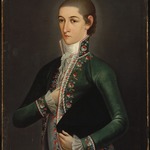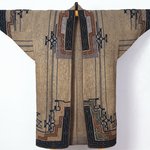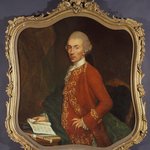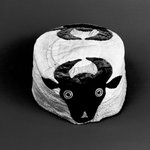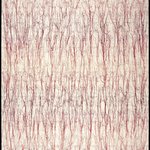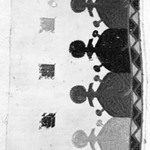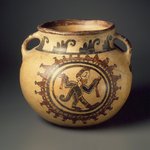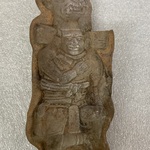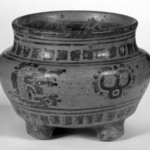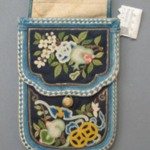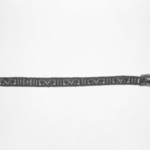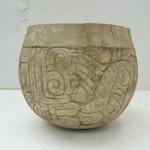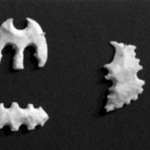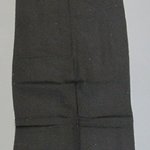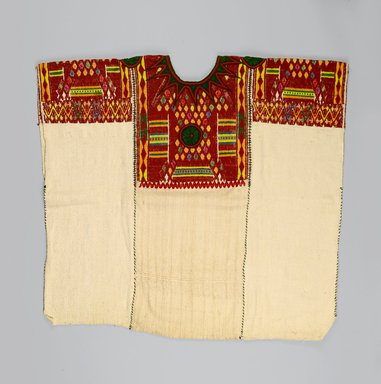
Woman's Blouse or Huipil
Arts of the Americas
Maya women in Guatemala wear traditional blouses, or huipil, as emblems of their ethnic and community identity. The multicolored geometric designs brocaded on the front, back, and shoulders of this huipil identify it as Quiche Maya from Chichicastenango. An abstract double-headed eagle motif appears on the front and back center panels as well as on the shoulders. Black silk appliqués decorate the sunburst design and four disks around the neck opening, representing the four cardinal directions.
In agricultural societies such as the Maya, clothing designs relate to the natural world and have the power to protect the wearer from supernatural harm. When opened and laid flat, the huipil design has cosmological significance: the head opening becomes the sun, surrounded by the four directions and other designs inspired by the natural world. The wearer is therefore placed at the center of the universe.
In agricultural societies such as the Maya, clothing designs relate to the natural world and have the power to protect the wearer from supernatural harm. When opened and laid flat, the huipil design has cosmological significance: the head opening becomes the sun, surrounded by the four directions and other designs inspired by the natural world. The wearer is therefore placed at the center of the universe.
CULTURE
Maya
MEDIUM
Cotton, silk
DATES
1930s or 1940s
DIMENSIONS
30 x 31 in. (76.2 x 78.7 cm) (show scale)



COLLECTIONS
Arts of the Americas
ACCESSION NUMBER
2005.15.1
CREDIT LINE
Gift in memory of Elizabeth Ege Freudenheim
CATALOGUE DESCRIPTION
Ceremonial blouse or huipil made of three four-selvedge panels of white cotton, brocaded on the front, back and shoulders. The multicolored design on the central panel represents the double-headed eagle, and the horizontal bars represent its wing and tail feathers. The neck opening with its silk appliqué of radiating points represents the sun, and the four rosettes represent the four directions.
Condition: good
MUSEUM LOCATION
This item is not on view
CAPTION
Maya. Woman's Blouse or Huipil, 1930s or 1940s. Cotton, silk, 30 x 31 in. (76.2 x 78.7 cm). Brooklyn Museum, Gift in memory of Elizabeth Ege Freudenheim, 2005.15.1. Creative Commons-BY (Photo: Brooklyn Museum, 2005.15.1_PS1.jpg)
IMAGE
overall, 2005.15.1_PS1.jpg. Brooklyn Museum photograph
"CUR" at the beginning of an image file name means that the image was created by a curatorial staff member. These study images may be digital point-and-shoot photographs, when we don\'t yet have high-quality studio photography, or they may be scans of older negatives, slides, or photographic prints, providing historical documentation of the object.
RIGHTS STATEMENT
Creative Commons-BY
You may download and use Brooklyn Museum images of this three-dimensional work in accordance with a Creative Commons license. Fair use, as understood under the United States Copyright Act, may also apply.
Please include caption information from this page and credit the Brooklyn Museum. If you need a high resolution file, please fill out our online application form (charges apply).
For further information about copyright, we recommend resources at the United States Library of Congress, Cornell University, Copyright and Cultural Institutions: Guidelines for U.S. Libraries, Archives, and Museums, and Copyright Watch.
For more information about the Museum's rights project, including how rights types are assigned, please see our blog posts on copyright.
If you have any information regarding this work and rights to it, please contact copyright@brooklynmuseum.org.
RECORD COMPLETENESS
Not every record you will find here is complete. More information is available for some works than for others, and some entries have been updated more recently. Records are frequently reviewed and revised, and we welcome any additional information you might have.


